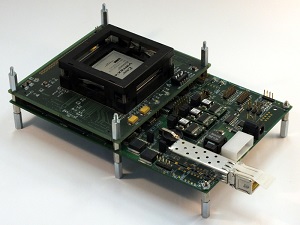FPGA (Field Programmable Gate Array) devices are integrated circuits containing a gate matrix that can be programmed by the end user in the fields.
In general, an FPGA device includes the following elements: configurable logic blocks (> 1 million gate), memory, high-performance computing unit (multipliers, microprocessors), high-speed I/O line (>1 Gbit/sec), programmable interconnections, and efficient distribution of clock signals.
The programming of the functionality of a device is made by the final user using relatively simple low cost development systems. The languages generally used are HDL, VHDL or Verilog.
FPGA devices are extremely versatile. In particular, in FPGA devices based on SRAM (Static Random Memory) technology, this feature implies: reprogrammable functionality in principle an arbitrary number of times, a single device that can be re-used for multiple applications, by reprogramming its functions, and finally the possibility to correct errors (even in orbit) by reprogramming.
However, this extreme flexibility of SRAM-FPGA devices results in a proven vulnerability to radiation (heavy ions and protons). In space and avionic applications, this can seriously compromise the behavior of the device, if appropriate countermeasures are not taken.
IASF Milan has been active in R&D projects concerning SRAM-FPGAs for years. In the following, we list the main projects.
FLIPPER

FLIPPER is a fault injection tool developed for SRAM-FPGAs that allows to simulate the occurrence of radiation induced faults, Single Event Upsets (SEU) within internal resources, i.e. configuration memory and reconfiguration logic. In SRAM-FPGAs, a user circuit is defined by configuration data stored in the SRAM memory cells that can be dynamically reconfigured a priori an unlimited number of times. Why Flipper? An SEU in the SRAM memory cells causes the alteration of the logical value of a memory cell content (“1s” becomes “0s” or “0s” becomes “1s”). This is commonly known as “bit-flip”. Hence the name.
FLIPPER was developed as part of an ESA/ESTEC contract 1855/04/NL/LvH/gm, in collaboration with Sanitas EG and was experimentally validated by means of accelerator irradiation tests.
If you need further information, please visit the pages on the use of reprogrammable FPGAs in space at the ESA/ESTEC web site.
SKA ADU
Digital board for the acquisition and processing of signals coming from the low frequency aperture array antennas (LFAA) of the SKA radiotelescope. For more information, please consult the ADU pages for SKA.
